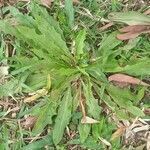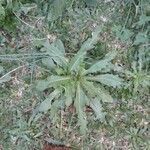Biennials or perennials, 30–70 cm; taproots vertical, deep, thick, caudices stout. Stems (1–5) erect or ascending, simple or sparingly branched distally, glabrous or pilose proximally. Leaves basal and proximally cauline; basal blades elliptic to oblanceolate, 60–200 × 10. 50 mm, margins coarsely and sharply dentate or 2-dentate, ciliate, faces glabrous or coarsely hirsute (cauline sessile, blades lanceolate, 50–100 × 10–30 mm, margins sharply dentate or pinnatifid; distal reduced, entire). Heads 1–10, in loose, paniculiform to corymbiform arrays . Involucres broadly campanulate, 10–20 × 5–20 mm. Phyllaries 20–30, linear-lanceolate, 4–15 mm, unequal, ± hirsute (at least medially). Florets 50–100+; corollas yellow, 5–7 mm, equaling phyllaries at flowering. Cypselae monomorphic, all beaked; bodies golden brown, fusiform, 8–10 mm, muricate, ribs 4–5; pappi of white, plumose bristles in 1 series, 6–8 mm. 2n = 8, 10.
A herb. It grows 20-50 cm tall. It keeps growing from year to year. It has a taproot and leaves grow in a ring. These leaves are narrowly oval and 5-10 cm long by 1-2 cm wide. There are coarse teeth along the edge.


